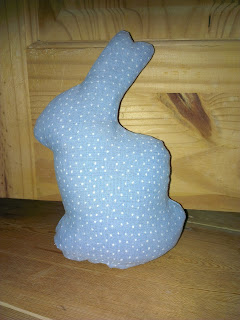This week I have been trying out a new pattern for me and making some oven mitts/pot holders. It was all a bit of an experiment to be honest but I did a very wonky test run - got positive feedback so thought I would run a few up to sit on the table at an upcoming craft fair.
I got myself completely organised and set up a little production line so that I would - in theory - be super duper time efficient. Unfortunately I wasn't as organised as I had thought and only had enough wadding for my test run and 2 more mitts. So I did that many and will have to return to make the others later. I'm proud of my good intentions but may have to work a bit harder on the pre-planning bit :)
If your going to do this project you will need
thread, patterned fabric, plain backing fabric, wadding, shape templates (can be printed out from internet), scissors, bias binding that compliments your patterned fabric and some pins. I think this one is easier if you have a sewing machine but certainly doable without!
So this is how I did it:
I printed out templates of the shapes I had chosen - heart, star and flower onto plain paper. I only have an A4 printer so made the shapes into halves and printed it this way. I laid the straight edge onto the fold in the fabric, pinned and cut out.
I then repeated this step for backing fabric and wadding. I then cut the backing fabric out a second time but this time cut the shapes in half along the fold line.
I laid the fabric in the order I wanted baking fabric then wadding and then pattered fabric and ironed. This is an important step as it causes the wadding to compress which makes it much easier to manage when sewing and cutting a fiddly shape.
Then take the two halves of the backing fabric and edge the straight seam. I did this by over locking it and then folding over and running a straight line stitch along it. When you do this ensure that you fold over on both halves the same side. When you lay the two halves onto the back of your shape you should see no raw edges on either side.
Now pin together and run a straight line stitch all the way around the edge of your shape trying to ensure you catch all the layers into your stitch.
Once you have done this trim with scissors as close as you can to your line of stitching. Remove any excess threads or pieces of wadding that are sticking out around the edges.
Now take your bias binding and fold around your shape. This is the trickiest bit and requires you to take it slowly and ensure the binding is tucked tightly around the shape.
It should look something like this now.
As you can see I added a loop of fabric to the corner of each so that the mit could be hung up in the kitchen. The idea of these is that they fold in half and your hand slips into the pockets.
Trim all your edges and check carefully for if there are any sections of bias binding that you have missed with your line of stitching. If there are you need to neaten that section up otherwise the mit will begin to look untidy very quickly when used.
So there you have it - a cute mit for handling those hot pots and pans. I think it would brighten up a kitchen but is also a cute idea for a gift.
I found that the flower became very tricky because of the tight curves so I kept sewing the bias binding without all of the layers in it when I hit the corners. I'll keep trying but didn't end up with a neat enough product to photograph this time. Maybe next week!
As always I have made these out of reclaimed fabrics so they are ethical and environmentally friendly.
Happy stitching :)
ps. it was lovely to climb up into my organized craft room this weekend so I have many good intentions to become an organised crafter - watch this space :)







































